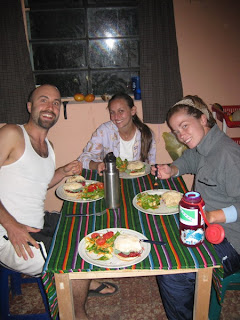 So we’ve seen no Easter bunny; we’ve gotten no baskets full of candy; there’s been no dying of Easter eggs or hunting for them either. But Guatemala is full of many other unique customs and traditions, all very pious as opposed to commercial. The entire week from Palm Sunday to Easter Sunday is called Semana Santa, or holy week.
So we’ve seen no Easter bunny; we’ve gotten no baskets full of candy; there’s been no dying of Easter eggs or hunting for them either. But Guatemala is full of many other unique customs and traditions, all very pious as opposed to commercial. The entire week from Palm Sunday to Easter Sunday is called Semana Santa, or holy week.Even before we had reached Antigua we had seen the creation of some beautiful alfombras (literally translated as carpets) and there were many more to come. The most common thing for these to be made of is very fine dyed saw dust, but can also include pine needles, beautiful flowers, candles, vegetables, fruits and other materials. They are made right in the middle of the streets and the dedication the people put into these is amazing;
 they are truly exquisite. After watching all their hard work we were shocked when we went back to look at them again later and they were gone! The street swept clean as if they had never been. The alfombras are the carpets for the processionals to walk over; made with extreme care, they are an offering to Jesus. Then the people would immediately be back out to start new alfombras for the next processionals.
they are truly exquisite. After watching all their hard work we were shocked when we went back to look at them again later and they were gone! The street swept clean as if they had never been. The alfombras are the carpets for the processionals to walk over; made with extreme care, they are an offering to Jesus. Then the people would immediately be back out to start new alfombras for the next processionals.The processionals. In Antigua there seemed to be at least 4 long processionals each day. You could tell when they were happening by the large cloud of incense preceding them, and the accompaniment of band music that was most closely related to a funeral dirge. The main attraction in these processions were the “floats.” I use
 that term only because I never caught the correct Spanish word. Unlike floats you might expect in a parade in the US, these are solid wood and heavy, depicting scenes of Jesus and his followers, and instead of being on wheels and pulled behind some vehicle, these are carried by the people. Often looking like their knees will soon buckle under the immense weight, the people happily partake in this tradition as a kind of penitence- feeling a similar weight and pain as that Jesus must have felt as he carried his cross to his crucifixion. Some of these are carried by only children as young as seven, others by men and women- everyone participates. They will carry these floats all throughout the city and over the alfombras until they return to the Church from whence they came.
that term only because I never caught the correct Spanish word. Unlike floats you might expect in a parade in the US, these are solid wood and heavy, depicting scenes of Jesus and his followers, and instead of being on wheels and pulled behind some vehicle, these are carried by the people. Often looking like their knees will soon buckle under the immense weight, the people happily partake in this tradition as a kind of penitence- feeling a similar weight and pain as that Jesus must have felt as he carried his cross to his crucifixion. Some of these are carried by only children as young as seven, others by men and women- everyone participates. They will carry these floats all throughout the city and over the alfombras until they return to the Church from whence they came.Similar to the processionals, there would also be reenactments. It is an interesting site when you see 4’7” Guatemalans all dressed up in Roman garb. Donny of course liked it because in this country as he stands in a crowd he can finally be the one to look over people’s heads instead of always jumping up to see what’s going on.

For Good Friday, the most important day of Semana Santa in Guatemala, the festivities start the night before and continue throughout Friday into the early morning hours on Saturday. We began our tour of the city around 11pm where we walk for about 5 hours, seeing the amazing carpets being made and stopping in at the various churches to pay our respects and watch the reenactments like the proclamation that Christ be crucified. At 4am Friday morning the whole town is still up, awaiting the start of the largest processional that would go from 4am to 2pm.
Antigua is one of the most beautiful cities in which to see all of this. They are acclaimed for having the most beautiful and intricate alfombras in the country and people come from far and wide (including Tom, Donny’s friend from Bend that we finally got to meet up with here). The parks and squares are full of street vendors selling everything from delicious food and ice cream to t
 he typical souvenirs seen here. Like being in Chichen Itza for the Equinox, we felt incredible blessed to be able to share this incredible cultural event with our new friends and families here in Antigua.
he typical souvenirs seen here. Like being in Chichen Itza for the Equinox, we felt incredible blessed to be able to share this incredible cultural event with our new friends and families here in Antigua.













